The Story Teller's Apprentice
Seminar Paper
“We are young, and the fire flickers, glowing, warm on our
cheeks. Staring, fixated by the undulating pulse of embers,
images form and disappear, faces peer back blinking.
Patches of intense colour in the flame; the azure of deep
water, deeply polished metal, mirror. Patterns in the wood
jump suddenly as structures collapse, the burning wood
settles sending up a bevy of sparks towards a star filled
sky, the infinite inky blue black, cold as the deep.
You throw in a pebble -
Another - Boys always need to play with fire.
But we are warm, snug in fleece. And listen, father is
painting a story, older than us, old as time, illustrated
in the stars, illustrated with the shadows from his
gesturing hands moving across the trunks of trees behind.
And deeper in the wood are other shadows, real and
imagined. We are gripped by curiosity, even though we know
the tale as our own, but ever to hear it again, each twist
and turn, stirring the embers deep within, fear, longing,
love, loss; a wild, dangerous journey.”
Thoughts on story telling,
narrative, imagery, and shadows.
Walking the coast path at St Alban’s head I came across a
stone bench facing the sea, carved with the names and dates
of a couple. We all seek to leave a mark, to mark the
passing of time, to mark our passing through time. Below
their names there is a quote:
“ Time passes. Listen. Time
passes”
The quote is from Dylan Thomas’s play ‘Under Milk Wood’ (I
looked it up on my return)
and it continues:
“Come closer now.
Only you can hear the houses sleeping in the streets in the
slow deep salt and
silent black, bandaged night. Only you can see, in the
blinded bedrooms, the
combs and petticoats over the chairs, the jugs and basins,
the glasses of teeth,
Thou Shalt Not on the wall, and the yellowing
dickybird-watching pictures of the
dead. Only you can hear and see, behind the eyes of the
sleepers, the movements
and countries and mazes and colours and dismays and
rainbows and tunes and
wished and flight and fall and despairs and big seas of
their dreams.
From where you are, you can hear their dreams...”
I start this seminar paper with a paragraph of my own
creation, setting out some ideas that I plan to explore,
and include a quote from Dylan Thomas, master teller of
stories, realising though this rediscovery what an
influence he has been on me. An evocation of childhood
experiences. Combinations of words, some running together,
conjuring up pictures:
“bridesmaided by glow-worms down the aisles of the
organplaying wood. The boys are dreaming wicked of the
bucking ranches of the night and the jollyrodgered sea”
“ It is night neddying among the snuggeries of babies.”
Storytelling as art, the painting of images with words,
creating worlds in the imagination.
The following quote is a few lines from Italio Calvino’s
‘If on a winter’s night a traveller’:
“Long novels written today are perhaps a contradiction: the
dimension of time has been shattered, we cannot love or
think except in fragments of time each of which goes off
along its own trajectory and immediately disappears. We can
rediscover the continuity of time only in the novels of
that period when time no longer seemed stopped and did not
yet seem to have exploded, a period that lasted no more
than a hundred years.”
In context I am not sure to what Calvino refers
specifically, but this quote points to the likes of James
Joyce, Surrealism, automatic writing, word association, a
stream of consciousness, beatnik poetry, the likes of Jack
Kerouac, who typed on a roll of tracing paper so as not to
break the continuity of his writing with carriage returns.
For me it was a passion for the Lyrics of Dylan, with songs
like Shelter from the Storm and Hard Rain. each line of the
lyric conjuring up an image, a story told in glimpses.
Sometimes without need for a precise order.
Glimpses:
I was walking the dog in the early morning, before dawn,
thinking about this assignment. I could not help but look
through the lit windows of kitchens and bedrooms, a frisson
of excitement, my eyes drawn to the light, into other
lives; private spaces, framed by windows.
A photograph comes to mind, two photographs actually, that
together tell a story. One is a self portrait, the
photographer stands in a very public place, the middle of a
busy shopping centre, legs akimbo, looking straight at the
camera. Passers by pass by. The second photo shows the same
woman, but taken from a small camera on the ground. A
second look at the first photo reveals the camera lying on
the pavement between her legs. This camera has taken the
same moment in time, but the image is taken of a very
private space.
The allure of the blue flashing lights on the roadside that
might offer a glimpse of a traffic accident, The lure of
the screen, perhaps this has a root in these voyeuristic
tendencies. Eyes drawn to Cleavage or bulge; instinctive. A
television that is on in a room pulling the eyes like a
magnet, stronger even than the pull of the embers. The
window is in itself like a screen, framing a world within.
The framed space becomes another space, arousing curiosity,
needing exploration, offering a possibility of escape,
leading us into other worlds, worlds of imagination, of
dream, of collective memories.
I am interested in exploring the concept of this frame
through a fragmented narrative of image and word, in the
place were word meets image, where still image meets moving
image, where the time is represented between the frames, or
caught in short sequences of reciprocating animation. And I
am interested in a recent manifestation of this frame; the
pebble-smooth iphone with it’s crystal screen.
I recently downloaded an application written for iPhone.
The piece is by Aya Karpinska, a New York based poet,
artist, game designer and ‘designer of interactive
experiences’.
A simulation of the application can be found on the
website: http://technekai.com/
Aya calls her piece a ‘zoom narrative’ it is called
‘Shadows Never Sleep’ and makes use of the iPhone’s touch
screen to create a children’s story of images and words.
In essence it is a very simple piece. Based on photographs
of a woman, dressed in the short pleated skirt and puff
sleeves of a Red Riding Hood, an Alice or a Wendy. White
silhouettes against black. The photographs bring classic
illustrators to mind: W Heath Robinson’s illustrations of
Hans Christian Anderson, Shakespeare, and the Arabian
Nights, Florence Samson’s ‘Aesop’s Fables’, Rackham, Mucha
and Beardsley, I am reminded of animators as well: Lotte
Reiniger and Norman McLaren.
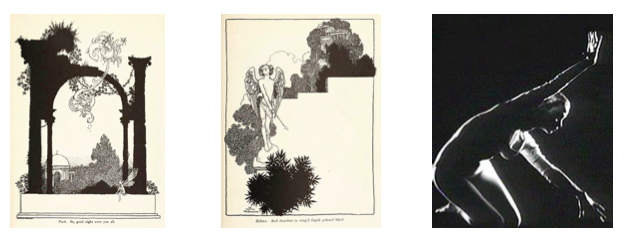
‘Shadows never sleep’ has
very minimal interaction, the viewer is presented with an
image of a girl asleep, and her silhouette or shadow rising
from the bed. Thus by implication the narrative that
follows is a dream sequence. By zooming in on this first
image the reader is taken to a set of nine squares with the
centre square blank, based on the ‘Sierpinski Carpet’ a
formula for a two dimensional tiled fractal. Further
zooming takes you to a second screen, where the pattern is
multiplied by itself to show a grid of nine by nine tiles.
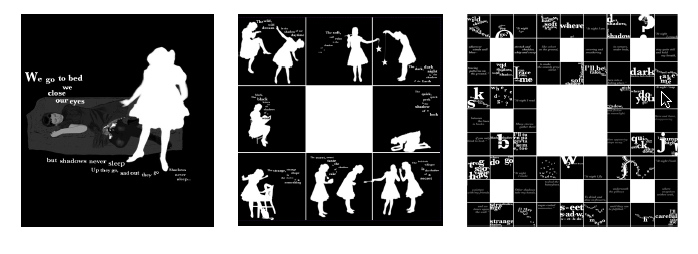
To navigate this large image
the narrative make use of the iPhones ‘flick panning’: the
way in which moving a fingertip across the screen will
cause the image to move, with the automatic easing that
makes the image continue to flow across the screen until it
comes to a graceful stop; an interactive ‘Ken Burns’
effect.
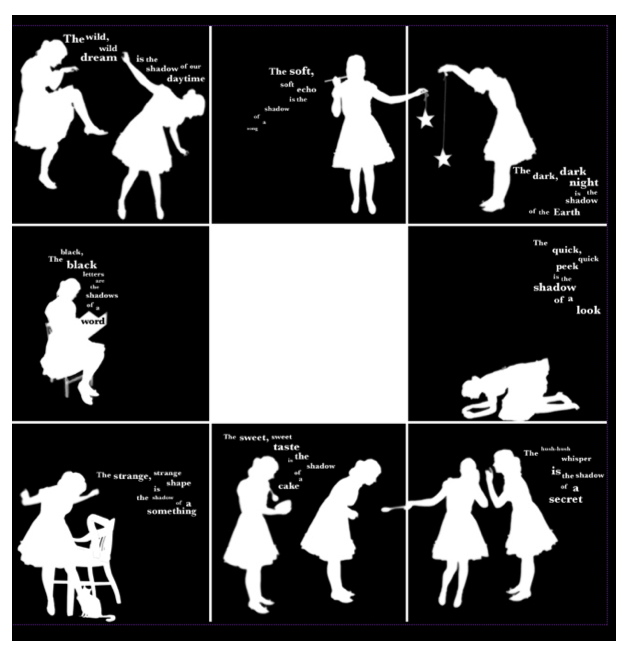
I would like to create
something along the same lines, a piece that is somewhere
in that place between still image and movie, a combination
of images and text, a short sequence of images, some still,
some that imply some movement in time, some that animate
with a touch of a finger. I have been experimenting with a
flash/web based story book, the content produced by my
students, the pages turned with a drag of the mouse. The
story in text, with the book looking like a story book, but
the illustrations animated on the page.
And I am also fascinated by the concept of the silhouette
as an illustrative device, interested that silhouette
illustration has become so entwined with fairy story. There
is some intertwining here between the concept of shadow,
with it’s echoes of Jungian psychology, the dark side, the
hidden, the menacing, the ‘other,’ and the silhouette, as a
flattened pictorial device, different from the chiaroscuro
of the comic book and film noir, perhaps more akin to mime,
the aesthetic in the gesture, form, the detail in the
outline on a flat two dimensional surface, a cut-out.
Aya Karpinska also produced an image sequence called ‘From
the Balcony’ using a set of photographs by Ana Luisa
Figueredo, intended to be viewed in the photo browser of
the iPhone. Both of these works are intended as children’s
story. Aya’s starting point was an exploration of the
tradition of children’s literature. I plan to base my own
work around the possibility of collaboration with my
students We have been experimenting with silhouette
animation and with animations that ‘scrub’ on an ipod or
screen. This area between still frame, short sequence and
animation is a very rich area for exploration, especially
in the context of work aimed at a young audience.
As with ‘Shadows Never Sleep’, ‘From the Balcony’ is in
essence very simple, using the iPhone to replicate the page
by page structure of a traditional children’s book. The way
in which a movement of the finger on the screen will change
the image, like the turning of a page, and the built in
accelerometer moving the image seamlessly as the device is
tilted from portrait to landscape.
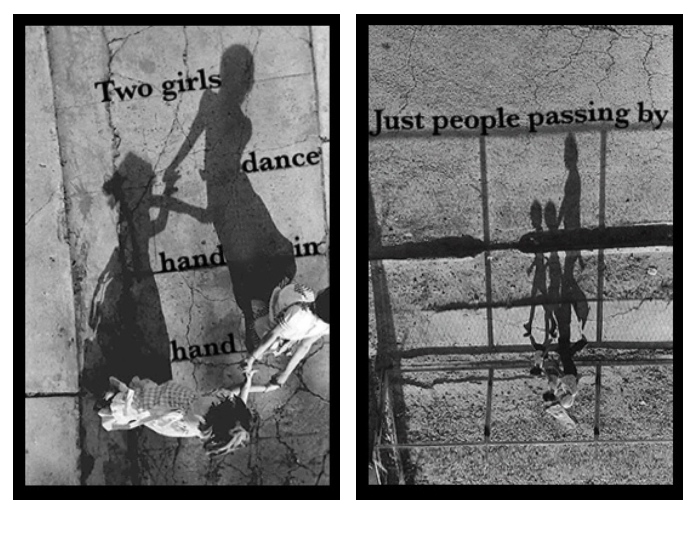
A narrative implies a
duration, a passage through time, a journey, an
exploration. Both of Aya Karpinska’s pieces have the feel
of the traditional book, with a beginning and an end. The
tactile nature of page turning replicated and replaced by
the touch sensitivity of the screen. In ‘Shadow’s Never
Sleep’ there is some limited choice as to the sequence in
which the text can be read, and by zooming out fully the
whole carpet of images and words can be seen at a glance.
It is this that I would like to explore.
Seeing a whole picture rather than glimpses seen scene by
scene on a time line.
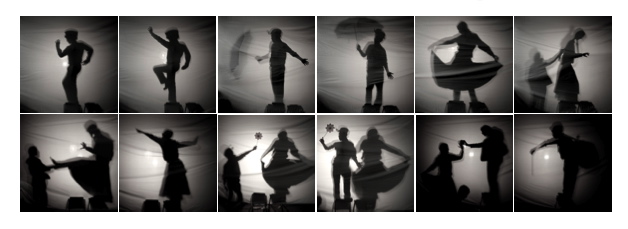
My students creating a
shadow play - a retelling of Hansel and Gretel
In writing about database narrative in his book ‘The
Language of New Media’ Lev Manovich touches on the
difference between random access media and
sequential-access media, stating that a book can be either
or both - a story to be read from beginning to end, or a
dictionary of reference material to be dipped into at any
point:
“For centuries, a spatialized narrative in which all images
appear simultaneously dominated European visual culture; in
the twentieth century it was relegated to 'minor' cultural
forms such as comics or technical illustrations. 'Real'
culture of the twentieth century came to speak in linear
chains, aligning itself with the assembly line of the
industrial society”
Linear chains, chained to time, or patterns that can be
seen whole, but explored in detail. (perhaps this is the
difference between a labyrinth and a maze). The choice as
to how the detail is explored, the element of time, how
much time to give to the exploration, this is the choice of
the audience. And the audience also augment the narrative
with the knowledge and experience they bring with them.
Having been immersed in the concept of the book from my
mother’s lap, it is impossible for me to imagine a life
without reading. In the summer I stood in the Duomo in
Florence, looking up at Brunelleschi’s extraordinary cupola
and the story of heaven and hell that the fresco painted on
it depicts. Towards the base of the fresco there are naked
figures in purgatory, chased by devils with flaming brands.
Towards the top figures of apostles leaning over a balcony.
The message is very clear - behave or be damned. This is a
cameo, or a series of glimpses that tell a story. And the
story would already have been well known to it’s intended
audience. Like Aya Karpinska’s ‘Shadow’s Never Sleep’ I can
see the story as a whole, or focus in on a single detail.
We may not know the specific detail, but we know the story,
we know the form, we know what to expect, we can read the
symbols. With a painting, We can see the story as a whole,
all at once, or zoom in on details within the bigger
picture, augmenting these with our own knowledge
understanding, making the connections. In the Duoma the
viewer has to climb the many steps to the upper gallery in
order to delight in details close up. But the climb is
rewarded by the chasm created by the extraordinary
perspective in the tiled floor far below, echoing the shape
of the lantern tower above. Brunelleschi has build the
story of heaven and hell into the very fabric of the
building. As media the Duoma is both immersive and
interactive.
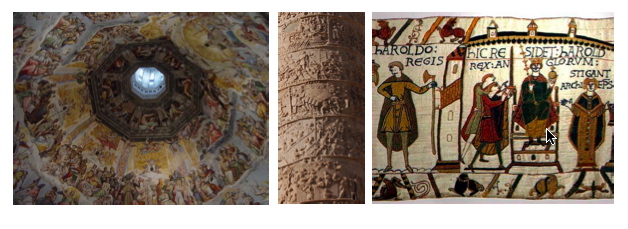
Trajan's Column or the
Bayeux Tapestry are similar examples, as are the majority
of the National Galleries collection of paintings. Have we
lost an ability to read these stories to some extent, or is
it there still in a collective subconscious, deeply
embedded? Rose on the prow of a virtual Titanic, holding
her arms wide, symbolically at a barrier that she may
cross, in the pose of Icarus, Christ; Capa’s Spanish
soldier, Goya’s peasant execution. A universal gesture
deeply ingrained in our visual culture.
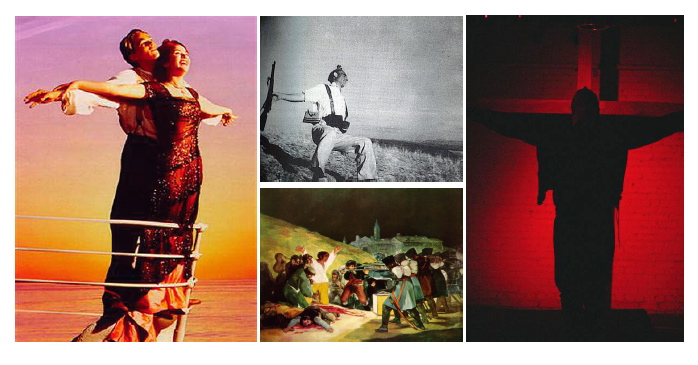
That particular image from
‘Titanic’ captures the essence of the movie in a single
frame, the movie poster, the Tablaux Vivant.
Also in Florence I also stood in front of Titan’s ‘Venus
D’Urbino’. With tears in my eyes. Why should this painting
have this cathartic effect on me? Tears were also in my
eyes as I stood in front of a Rothko, recently, staring
into a frame of free colour floating above the surface of
the canvas. As an art student I have learned a language
with which to appreciate this work, a language that would
have Brunelleschi bemused I am sure. The still image is the
apex of Freytag’s triangle, the cathartic moment of
Aristotle’s ‘poetics’ with the other elements provided by
my learning and memory, the picture that I build in my head
that is based on my learning and memory.
It is impossible for me to imagine life without reading,
and impossible to imagine how it would be to look at image
without the knowledge of pictorial perspective. Having
learned the conventions of perspective as pioneered by
Brunelleschi it is not possible to see without this
knowledge, except perhaps through the eyes of a young
child. Equally I bring with me all my learning, both
individual and through the collective culture and time into
which I have been born. Similarly art must reflect the
culture and time in which it is created, the languages can
be developed, but not un-learned. Much of the art of the
first half of the 20th century was based on collage,
montage, mosaic. I was standing in front of a large pop art
collage at the Pallant House Gallery, a piece that can seen
as a whole, or read bit by bit, by connotation, by
association, by connection, by juxtaposition. And over the
same period artists such as Dziga Vertov with his clasin ‘
Man with a Movie Camera’ were developing the language of
the moving image:
“Montage aims to create visual, stylistic, semantic, and
emotional dissonance between different elements. In
contrast, compositing aims to blend them into a seamless
whole, a single gestalt.”
If this is in essence the language of film, what will be
the language of the new media? Manovich would argue that it
is database based. The database has become a very powerful
entity in many areas of contemporary society. He also
speaks of multiple frames, multiple windows creating a
‘spacial montage’:
“Time becomes spatialized, distributed over the surface of
the screen.”
Most films are story boarded as a part of the production
process. Time is represented in the gutters between the
images. One of the images in Aya Karpinska’s ‘Shadows Never
Sleep’ crosses from one frame to the next, breaking the
convention of the frame, altering the embedded conception
of the frame as framing time, similar perhaps to the way in
which Woody Allen will suddenly talk to camera in ‘Annie
Hall’; breaking the mimetic flow. of the narrative. A comic
book, as Manovich points out in the quote above, shares the
attributes of a collage with those of liner narrative. In
film the viewer is gradually given clues, fed a little at a
time. A film may not follow time, but the narrative itself
evolves over time. In Catch 22 for example, the first scene
is also the last, although in the first scene there is no
sound, and no knowledge as yet of the context of the
action. Through both film and book the audience is fed the
same scene repeatedly, but with a little more information
each time the scene is replayed.
In montage all the elements of the piece are seen at once.
Somewhere in between there are works such as Zbig
Rybczynski’s reciprocating animation ‘Tango’ and Bill
Viola’s ‘The Passions’. Perhaps the other way about in the
films of Peter Greenaway. A favourite of mine currently is
a flash based web ‘object’ called ‘Dominique’
which is simply the facial features of a young woman on a
white background. Movement of the mouse and clicking of the
mouse buttons makes the model blink, smile, pout, wrinkle
her nose. There is nothing more to the site than this.
As I have stated I am interested in exploring the space
between still image and moving image, sequences of images,
images combining with text, a story told through multiple
images, frames; the time frame and the picture frame, and
interactivity.
There is great potential for exploring this in relation to
the iPhone, with it’s ability to detect motion, sound, and
react to image via it’s built in camera.

A still frame from my students
animation ‘bob and bobbina’ - a retelling of Hansel and
Gretel
The story that Aya Karpinska
presents with ‘Shadows Never Sleep’ is very simple, and all
the more charming for this. Some of the images are not too
clear, and I am not clear if this is intentional or not.
Neither am I sure to what extent this piece will entertain
the younger child that it is perhaps aimed at. I suspect
that it is much more interesting currently as a curiosity
to the more typical owner of an iPhone, but as an
interactive story for children I can see huge potential in
this. To be able to navigate through a story, perhaps using
the iPhone’s motion detector to move around an image, like
a virtual ‘ball and maze game’, or to jump to another view
with a voice command, a click of the finger, or to zoom
back and forth through multiple images, each growing from
the previous. Perhaps using the camera to scan QR codes on
actual objects, to that the phone can participate in a
story based partly in the physical realm of books and
objects. I also enjoy the visual simplicity and complexity
of silhouette, and the anticipate the possibilities of
working with students, working with shadows and animation.